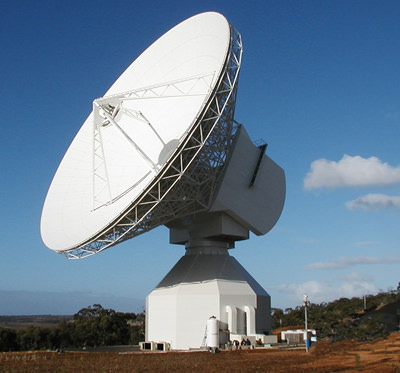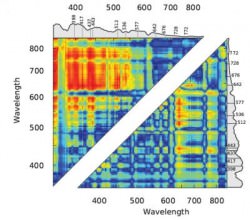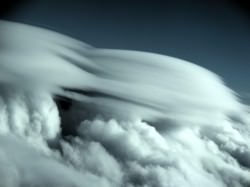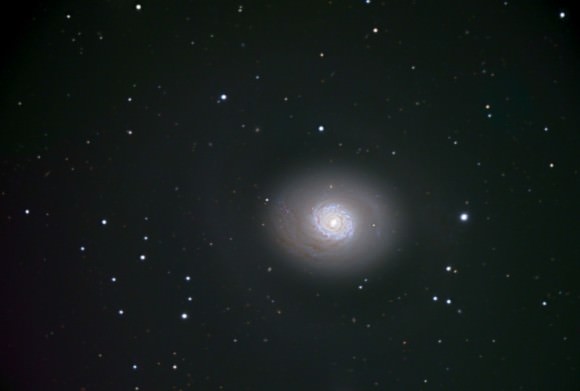New, Deep Image of Virgo Cluster Reveals Galaxy Cut Short in its
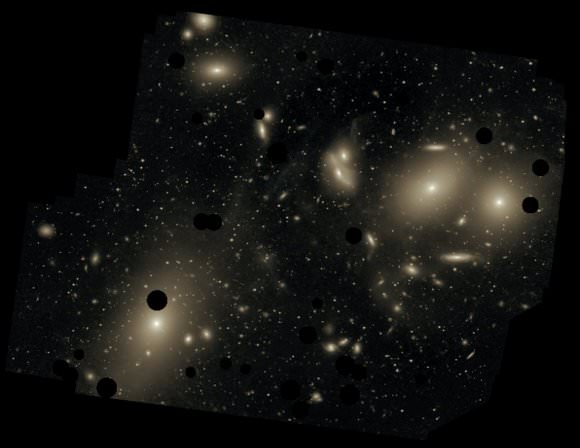
Astronomers have peered deep inside the Virgo cluster, and measured the size of one of its most famous members — Messier 87 — with surprising results.
The giant elliptical galaxy isn’t quite as giant as previously believed.
This deep image of the Virgo Cluster, obtained by Chris Mihos of Case Western Reserve University and his colleagues using the university’s Burrell Schmidt telescope, shows the diffuse light between the galaxies belonging to the cluster. North is up, east to the left. The dark spots indicate where bright foreground stars were removed from the image.
(...)
Read the rest of New, Deep Image of Virgo Cluster Reveals Galaxy Cut Short in its Youth (559 words)
A Cold and Wet History on Early Mars?
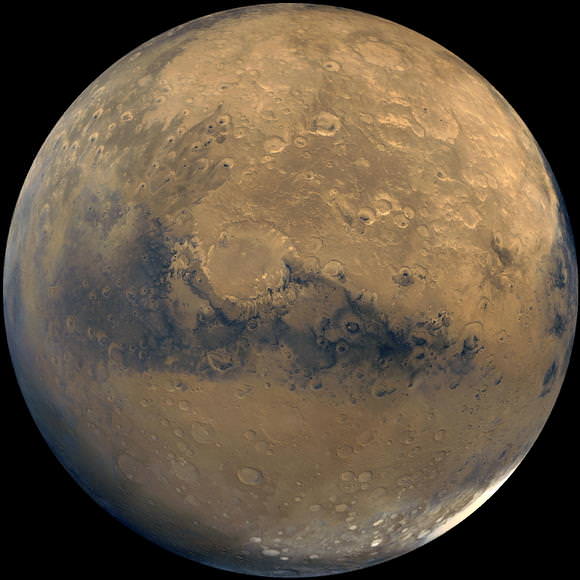
Even if an early Mars never got above freezing, the brine on its surface could have stayed liquid and supported life, a new study says.
Lead author Alberto G. Fairen, of NASA Ames Research Center in Moffett Field, California, and his colleagues have analyzed the behavior of Martian chemical concentrations found at various mission landing sites, and revealed that warm temperatures wouldn’t have been necessary to support salt-loving life forms.
(...)
Read the rest of A Cold and Wet History on Early Mars? (196 words)
Where In The Universe #55
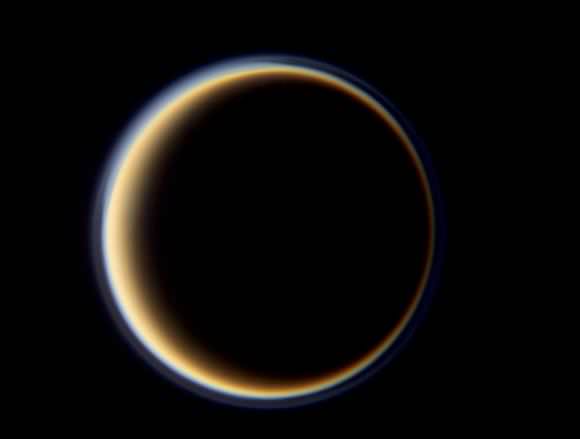
Are you ready for another Where In The Universe Challenge? Take a look and see if you can name where in the Universe this image is from. Give yourself extra points if you can name the spacecraft responsible for the image. As usual, we’ll provide the image today, but won’t reveal the answer until tomorrow. This gives you a chance to mull over the image and provide your answer/guess in the comment section. Please, no links or extensive explanations of what you think this is — give everyone the chance to guess.
(...)
Read the rest of Where In The Universe #55 (0 words)
IYA Live Telescope Today: Jupiter and Neptune Conjunction - M19
![]() Hey, hey! We’re baaaack… Due to some technical difficulties, our eye on the southern sky has been down for a short time, but I’m happy to report that we’re back up and running again. If you missed our broadcast yesterday and today, have no fear. We recorded the Jupiter and Neptune conjunction for you and captured Messier 19 today, too! Come on… You know you want to look! (...)
Hey, hey! We’re baaaack… Due to some technical difficulties, our eye on the southern sky has been down for a short time, but I’m happy to report that we’re back up and running again. If you missed our broadcast yesterday and today, have no fear. We recorded the Jupiter and Neptune conjunction for you and captured Messier 19 today, too! Come on… You know you want to look! (...)
Read the rest of IYA Live Telescope Today: Jupiter and Neptune Conjunction - M19 (231 words)
Herschel Phones Home — Literally
For the first time in spaceflight history, a satellite has used mobile phone technology to radio back to Earth. The Herschel spacecraft – which launched on May 14, called home two days later using the same technology used in GSM mobile phone networks to send test data to ESA’s deep space tracking station. “Herschel’s 1.5-Mbps test transmission - roughly the same data rate provided by a home broadband Internet connection - was picked up at ESA’s ESTRACK station at New Norcia, Australia, on Saturday, as the satellite was travelling some 280 000 km from Earth,” said John Dodsworth, the Herschel-Planck Flight Operations Director.
(...)
Read the rest of Herschel Phones Home — Literally (219 words)
Cosmologists Improve on Standard Candles Measurement
Cosmologists have found a new and quicker technique that establishes the intrinsic brightness of Type Ia supernovae more accurately than ever before. These exploding stars are the best standard candles for measuring cosmic distances and are the tools that made the discovery of dark energy possible. An international team has found a way to do the job of measuring stellar distances in just a single night as opposed to months of observations by simply measuring the ratio of the flux (visible power, or brightness) between two specific regions in the spectrum of a Type Ia supernova. With this new method, a supernova’s distance can be determined to better than 6 percent uncertainty.
(...)
Read the rest of Cosmologists Improve on Standard Candles Measurement (389 words)
Poetry in Space: Final Pilgrims to the Hubble Space Telescope
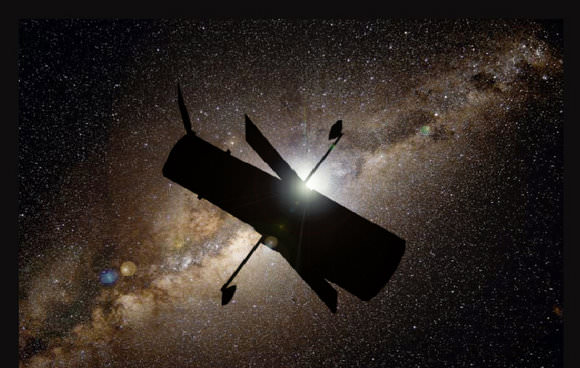
As today’s final spacewalk of the Hubble Servicing Mission begins, it seems very fitting to share a poem written by my friend Stuart Atkinson. Stuart is a poet, a blogger, a member of Unmanned Spaceflight.com (which means he is a Photoshopper extraordinaire!) and a passionate promoter of space exploration. Stuart has written many touching poems previously about the Mars rovers, the Phoenix lander, the Kepler mission and many other missions, but this verse about the final human mission to the Hubble Space Telescope is priceless. See below for “The Final Pilgrims” and check out Stu’s website Cumbrian Skies for more great poetry, images and information.
(...)
Read the rest of Poetry in Space: Final Pilgrims to the Hubble Space Telescope (9 words)
3 new stories for 2009/05/19
A team of atmospheric chemists has moved closer to what’s considered the “holy grail” of climate change science: the first-ever direct detections of biological particles within ice clouds. Ice in Clouds Experiment - Layer Clouds (ICE-L) team mounted a mass spectrometer onto a C-130 aircraft and made a series of high-speed flights through a type of cloud known as a wave cloud. Analysis of the ice crystals revealed that the particles that started their growth were made up almost entirely of either dust or biological material such as bacteria, fungal spores and plant material. While it has long been known that microorganisms become airborne and travel great distances, this study is the first to yield direct data on how they work to influence cloud formation.
(...)
Read the rest of First Observations of Biological Particles in High-Altitude Clouds (371 words)
Hubble Servicing Mission 4 in Pictures, Part 1
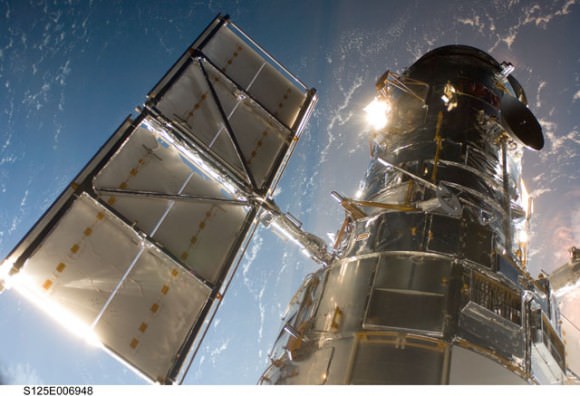
The long-awaited Servicing Mission 4 for the Hubble Space Telescope has provided drama, nail-biting excitement, fist-pumping triumphs and ‘what else could go wrong now’ moments. But the best way to to describe the mission is to let the amazing images from the EVAs do the talking. Below are high-resolution images from NASA, highlighting the first three spacewalks.
(...)
Read the rest of Hubble Servicing Mission 4 in Pictures, Part 1 (793 words)
M94 - The “Cat’s Eye” Galaxy by Roth Ritter
About 13 million light-years away in the constellations Canes Venatici, there’s a cloud. No, it’s not the same clouds that most of us have been experiencing lately - but a cluster of galaxies which appear form a single large cloud-like structure. The one we’re focusing on is Canes Venatici I, just a small section of the Virgo Supercluster and just moving along with the expansion of the Universe. In it we see a galaxy that stands out from the crowd for a very good reason… it has very little or no dark matter. It’s name? Messier 94. (...)
Read the rest of M94 - The “Cat’s Eye” Galaxy by Roth Ritter (1,212 words)
Is Everything Made of Mini Black Holes?
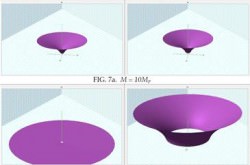
In 1971 physicist Stephen Hawking suggested that there might be “mini” black holes all around us that were created by the Big Bang. The violence of the rapid expansion following the beginning of the Universe could have squeezed concentrations of matter to form miniscule black holes, so small they can’t even be seen in a regular microscope. But what if these mini black holes were everywhere, and in fact, what if they make up the fabric of the universe? A new paper from two researchers in California proposes this idea.
(...)
Read the rest of Is Everything Made of Mini Black Holes? (422 words)
Amazing Images of Shuttle and Hubble Transiting Sun

No, these aren’t sunspots finally appearing on our currently quiet sun. Check out these great images taken by NASA photographer Thierry Legault. The “spots” are actually the space shuttle Atlantis and the Hubble Space Telescope transiting across the sun! Legault’s website says these are the only images ever taken of a transit of a shuttle and the HST in front of the Sun. Legault was in Florida at the time he took this image, about 100 km south of the Kennedy Space Center on May 13th 2009 12:17 local time, several minutes before grapple of Hubble by Atlantis. The transit only lasted .8 seconds, and Legault was able to snap 4 images a second, getting a total of 16 different shots of the entire event (he started shooting 2 seconds before the predicted transit.)
He took another image the previous day of just the shuttle transiting (see below.)
(...)
Read the rest of Amazing Images of Shuttle and Hubble Transiting Sun (104 words)
NASA Science News for May 15, 2009
Have you ever wondered how you'd make your morning coffee if you were living on another planet? NASA engineers have power systems on the drawing board that could run coffee makers--and so much more--on the Moon, Mars and beyond.
FULL STORY at
http://science.nasa.gov/headlines/y2009/15may_stirling.htm?list1035898
NASA Science News for May 11, 2009
After a smooth countdown and picture-perfect liftoff, space shuttle Atlantis and a crew of seven astronauts are in space, ready to begin their 11-day mission to service NASA's Hubble Space Telescope. Atlantis lifted off Launch Pad 39A at NASA's Kennedy Space Center in Florida at 2:01 p.m. EDT on May 11th.
FULL STORY at
http://science.nasa.gov/headlines/y2009/11may_hubblemission1.htm?list1035898
NASA Science News for May 6, 2009
NASA-supported researchers have figured out why Salmonella bacteria become more virulent when they travel on board spaceships. They've also learned how to calm the bacteria down again--a trick that could come in handy for fighting diseases here on Earth.
FULL STORY at
http://science.nasa.gov/headlines/y2009/06may_salmonella.htm?list1035898
